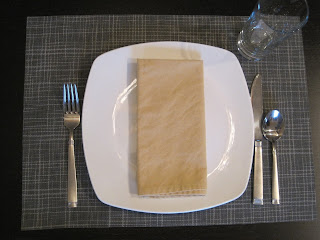Background: For the last few years, we have spent one or two nights after Christmas writing thank you notes for our Christmas gifts. We don't send them to everyone, but at the bare minimum grandparents and out-of-town givers get a thank you note (since they didn't see you open it and there is always the question if you even got it in the mail). And of course Santa gets one (It is the principle here- If you can take the time to write him a letter of what you want, then you better take the time to say thanks when he brings it to you). Depending on the age of your children, they could also send notes to cousins, aunts, friends, teachers, etc.
Attention Getter: We tossed a little bean bag around the table and when you caught it you said something that you got for Christmas. Sometimes I labeled the round like "What Santa gave you" or "What Grandma P gave you" etc. (You know you are spoiled when you have multiple rounds.) This facilitated the note writing later because it was fresh in their mind.
Then I told them we were going to write thank you notes for the gifts we received.
(Now think outside the box here. A thank you note doesn't have to be a note card in an envelope. Let your kids express themselves however they want- just supply the materials: markers (I know I am not the only sucker for a sharp sharpie), crayons, computer paper, lined paper, note cards, stamps, scrapbook paper, etc.)
Why: You know all the surface reasons, but it is interesting to consider that gratitude must be cultivated and developed. It is a learned response and writing thank you notes is great practice for our kids in expressing and feeling gratitude. Plus it will make grandmas' day.
I have kids of 3 different ability levels so their thank you notes were all different.
Toddler/Preschooler: I had my daughter draw a picture for grandma. Then she dictated to me what she wanted to say and I wrote it on the paper. She signed her name. You could also write at the bottom of the page "Thank you for the ___________" and your child writes in the blank.

Grade Schooler: My son is in kindergarten and he can write all his letters and although he can sound-spell pretty well he prefers me to spell out every word. (I don't have the patience for this) So we created a word bank that he could reference as he wrote. We brainstormed words that we might use in their thank you notes. My older daughter referenced this as well.


Independent: My oldest child can write and "think" on her own for the most part. But I still wanted to teach her how to write a thank you note. I believe every thank you note should have a bit of 'personal' so this is the formula I taught her:
1. Greeting
2. Thank them for the gift specifically. "Thanks for the doll" vs "Thanks for the gift"
3. Then write a follow up statement. "I played with her today" or "She is pretty" or "I have fun getting her dressed." Just say something that shows you appreciate it and have thought about it. ( I hate that note in the mail from the bride that just says "Thanks for the gift" in an extra large handwriting to take up space.)
4. Thoughtful Closing

My husband and I even participated in the activity. This shows our kids that we abide my the same expectations.

Follow-Up: We hand delivered the notes that we could. And we mailed the rest. There were warm fuzzies all the way around.














